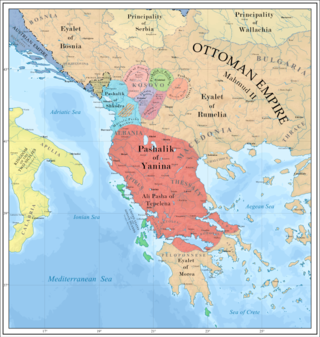
Ismail Qemali, sometimes spelled as Ismail Kemal in old diplomatic correspondence, was an Albanian politician and statesman who is regarded as the founder of modern Albania. He served as the first prime minister of Albania from December 1912 until his resignation in January 1914.
Mustafa Pasha Bushatli, called Ishkodrali, was a semi-independent Albanian Ottoman statesman, the last hereditary governor of the Pashalik of Scutari. In 1810 he succeeded Ibrahim Bushati and ruled Shkodër until 1831.

Vizier Omer Pasha Vrioni was an Ottoman Albanian military commander and ruler, and a prominent figure in the Greek War of Independence. He succeeded Ali as Pasha of Yanina.

Reşid Mehmed Pasha, also known as Kütahı, was an Ottoman statesman and general who reached the post of Grand Vizier in the first half of the 19th century, playing an important role in the Greek War of Independence.

The Pashalik of Scutari, Iskodra, or Shkodra (1757–1831), was an autonomous and de facto independent pashalik created by the Albanian Bushati family from the previous Sanjak of Scutari, which was situated around the city of Shkodër in modern-day Albania and large majority of modern-day Montenegro. At its peak during the reign of Kara Mahmud Bushati the pashalik encompassed much of Albania, most of Kosovo, western Macedonia, southeastern Serbia and most of Montenegro. Up to 1830 the Pashalik of Shkodra controlled most of the above lands including Southern Montenegro.

The Pashalik of Yanina, sometimes referred to as the Pashalik of Ioannina or Pashalik of Janina, was an autonomous pashalik within the Ottoman Empire between 1787 and 1822 covering large areas of Albania, Greece, and North Macedonia. Under the Ottoman Albanian ruler Ali Pasha, the pashalik acquired a high degree of autonomy and even managed to stay de facto independent, though this was never officially recognized by the Ottoman Empire. Conceiving his territory in increasingly independent terms, Ali Pasha's correspondence and foreign Western correspondence frequently refer to the territories under Ali's control as Albania.
Mehmed Pasha Bushati was the governor of the Pashalik of Scutari and founder of the Bushatli dynasty of Shkodër

The Pashalik of Berat was a pashalik created in modern-day central Albania by Ahmet Kurt Pasha in 1774 and dissolved after Ahmet's ally, Ibrahim Pasha of Berat was defeated by Ali Pasha in 1809, thus incorporating the pashalik, with the Pashalik of Janina. This pashalik was one of the three pashaliks created by Albanians in the period of Albanian Pashaliks.

The Albanian Pashaliks were three semi-independent pashaliks ruled by Albanian pashas from 1760 to 1831 and covering the territory of modern Albania, Kosovo, most of Montenegro, southern Serbia, western North Macedonia and most of mainland Greece. The degree of independence of these pashaliks varied over time, from semi-autonomous to de facto independent.
The Albanian revolts of 1833–1839 took place in Albania as a reaction against the new centralizing policy of Ottoman administration.
Xhelil Bega or Çelo Picari (1801–1880) was an Albanian revolutionary leader of the Albanian Revolt of 1847.

The Republic of Central Albania was a short-lived unrecognised state established on 16 October 1913, with its administrative centre in Durrës, today in Albania.

The Sanjak of Scutari or Sanjak of Shkodra was one of the sanjaks of the Ottoman Empire. It was established after the Ottoman Empire acquired Shkodra after the siege of Shkodra in 1478–9. It was part of the Eyalet of Rumelia until 1867, when it became a part, together with the Sanjak of Skopje, of the newly established Scutari Vilayet. In 1912 and the beginning of 1913 it was occupied by members of the Balkan League during the First Balkan War. In 1914 the territory of Sanjak of Scutari became a part of the Principality of Albania, established on the basis of the peace contract signed during the London Conference in 1913.
The Albanian revolt of 1845, known Revolt of 1845 between Albanians was one of the 19th-century uprisings in Ottoman Albania directed against the Ottoman Tanzimat reforms.
Zylyftar Poda, born Iljaz Poda and also known as Silihtar Boda, was an Albanian leader, who led several revolts against the Ottoman Empire.
The Taksim meeting alternatively known as the Taksim Plot and less commonly as the Taksim Assembly was a secret meeting held in January 1912 by Albanian nationalist deputies of the Ottoman parliament and other prominent Albanian political figures. The event gets its name from Taksim Square because of the location of the house where it was held. The meeting was organized on the initiative of Hasan Prishtina and Ismail Qemali, Albanian politicians, who invited most of the MPs of Albanian origin and aimed at launching an armed general uprising in Albanian territories against the central government headed by the Committee of Union and Progress (CUP). The meeting followed two other Albanian uprisings of 1910 in the Vilayet of Kosovo and 1911 in the mountains of upper Shkodra. The Taksim meeting resulted in an uprising the same year, with armed uprisings in Shkodër, Lezhë, Mirditë, Krujë and other Albanian provinces, which exceeded the organizers' expectations. The biggest uprising was in Kosovo, where the rebels were more organized and managed to take over important cities like Prizren, Peja, Gjakova, Mitrovica and others.

The Sanjak of Durrës was one of the sanjaks of the Ottoman Empire. It was named for its capital Durrës and was also known as the Sanjak of Durazzo from its capital's Italian name. The sanjak was composed of the kazas of Durrës, Tirana, Shijak, Kavajë, and Krujë. The Sanjak of Durrës formed the southern half of the Vilayet of Scutari. The northern half was the Sanjak of Scutari. Durrës Sanjak also bordered the sanjaks of Manastir and Dibra to its northeast and the sanjak of Elbasan to the east and south. Its western border was the Adriatic Sea. Its terrain is generally flat and plain. Only the eastern parts of the kazas of Tirana and Kavajë were mountainous.

Notis Botsaris was a Souliote fighter and general in the Greek Revolution of 1821. He was the son of the late Giorgis Botsaris and was the leader of the Souliote fara of the Botsari.
The First Scutari-Berat War was a military conflict between the Pashalik of Scutari under Mehmed Pasha Bushati against the Pashalik of Berat under Ahmet Kurt Pasha, who fought over the Sanjak of Durrës.
The Second Scutari-Berat War was a military invasion launched by Mustafa Pasha of the Pashalik of Scutari against the Pashalik of Berat under Ahmet Kurt Pasha.









